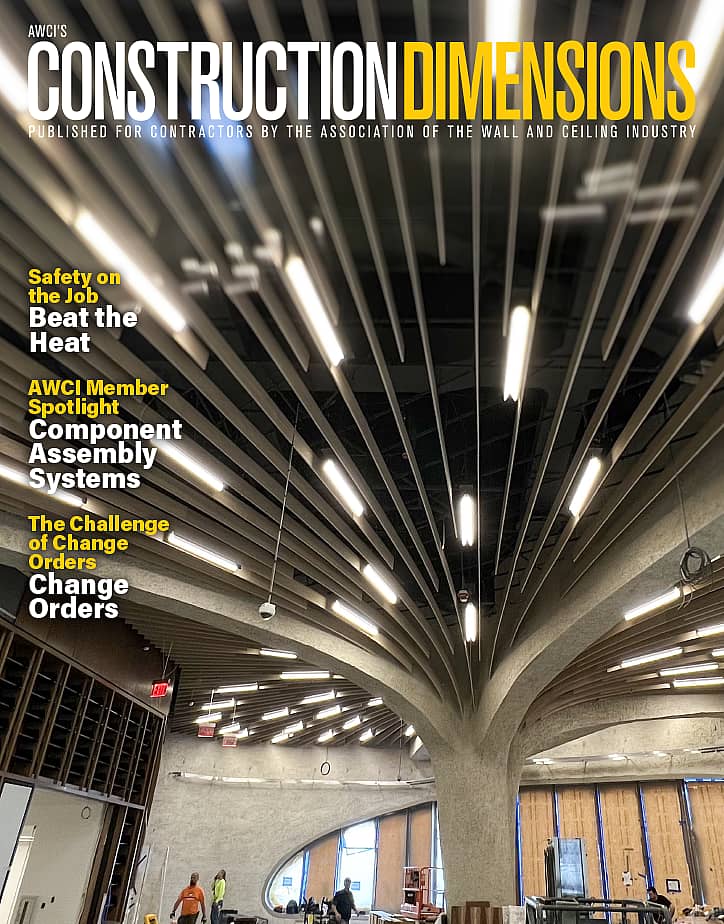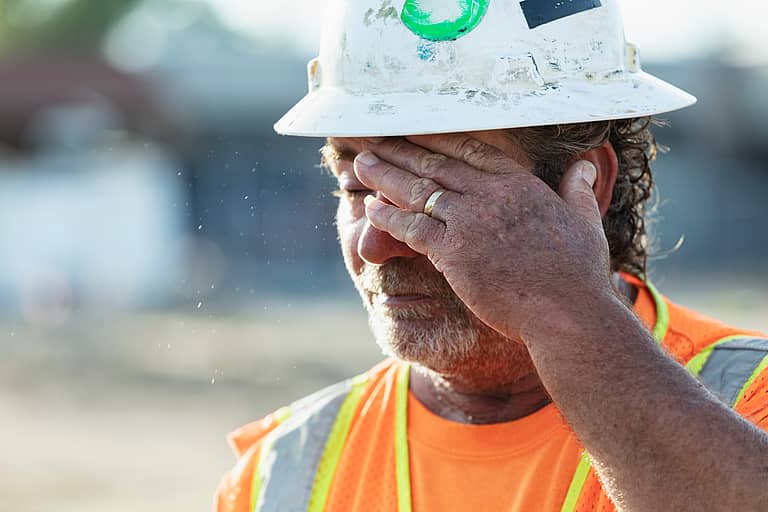Construction Firms Add 2,000 Jobs in November
Construction sector job gains slowed in November as firms added only 2,000 jobs, but wages for hourly employees accelerated and the number of unfilled positions reached record highs in October, the Associated General Contractors of America reported in analyzing new government data. Association officials said the new figures indicate the slowdown in hiring is likely because of workforce shortages instead of declining need for labor.
“The steep rise in pay for craft and other hourly workers, along with an earlier report of record job openings heading into November, indicate that contractors are still struggling to find enough skilled workers,” said Ken Simonson, the association’s chief economist. “The slowdown in employment is a sign of how tight the job market is, not an indication that construction demand is lagging.”
Average hourly earnings for production and nonsupervisory employees in construction—covering most onsite craft workers as well as many office workers—climbed by 5.9% over the year to $34.96 per hour. Wage growth accelerated from 5.5% in October. Construction firms in November provided a wage “premium” of more than 19% compared to the average hourly earnings for all private-sector production employees.
Construction employment in November totaled 8,033,000, seasonally adjusted, an increase of 2,000 from October. The sector has added 200,000 jobs during the past 12 months. That was a gain of 2.6%, which outpaced the 1.8% job growth in the overall economy. Residential building and specialty trade contractors added 1,000 employees in November and 53,000 (1.6%) over 12 months. Employment at nonresidential construction firms—nonresidential building and specialty trade contractors along with heavy and civil engineering construction firms—climbed by 1,400 positions for the month and 147,800 (3.2%) since November 2022.
A report on job openings released by the government showed there were 457,000 openings in construction at the end of October, the highest October total in the 23-year history of the series. Simonson said this was a strong sign that contractors remain eager to hire and that the dip in employment gains in November is more likely a sign of the dearth of qualified workers rather than a slowdown in demand for projects.
Construction Materials Prices Dip 0.3% in November
Construction input prices decreased 0.3% in November compared to the previous month, according to an Associated Builders and Contractors analysis of the U.S. Bureau of Labor Statistics’ Producer Price Index data released Dec. 13. Nonresidential construction input prices decreased 0.3% for the month as well. Inputs to construction are still nearly 39% higher than at the start of the COVID-19 pandemic.
Overall construction input prices are 0.8% lower than a year ago, while nonresidential construction input prices are 0.4% lower. Prices decreased in two of the three energy subcategories last month. Crude petroleum input prices were down 9.5%, while unprocessed energy materials prices were down 3.2%. Natural gas prices rose 24.1% in November.
“Construction input prices declined for the second straight month in November,” said ABC Chief Economist Anirban Basu. “While much of the recent decline is due to record domestic oil production and the resulting precipitous decline in gas and diesel prices, other commodities like iron and steel and lumber products are currently more affordable than they were at the same time last year.
“Falling, or at the very least stable, input prices should help to control construction cost increases in the coming quarters,” said Basu. “This is a welcome development for an industry still dealing with extraordinarily elevated financing costs and rising labors costs due to ongoing worker shortages.”
Dodge Momentum Index Decreases 1% in November
The Dodge Momentum Index, issued by Dodge Construction Network, decreased 1% in November to 179.2 (2000=100) from the revised October reading of 181.7. Over the month, the commercial and institutional components both fell 1%.
“While both portions of the momentum index saw slower momentum in planning, overall levels remain steady and will support construction spending in 2024 and 2025,” stated Sarah Martin, associate director of forecasting for DCN. “Nonresidential planning activity will remain constrained from stronger growth amidst ongoing labor and construction cost challenges.”
Excluding data center activity, all commercial segments saw declines in November. On the institutional side, more momentum in healthcare and public projects was offset by continued weakness in education planning. Year over year, the DMI was 14% lower than in November 2022. The commercial segment was down 20% from year-ago levels, while the institutional segment was up 2% over the same time period.
A total of 17 projects valued at $100 million or more entered planning in November. The largest commercial projects include the $480 million Project Cosmo Data Center in Cheyenne, Wyoming, and the $300 million Sherwin Williams Headquarters Building in Cleveland. The largest institutional projects include the $315 million phase two of the FSU Health Hospital in Tallahassee, Florida, and the $258 million LA Convention Center Exhibition Hall in Los Angeles.
The DMI is a monthly measure of the value of nonresidential building projects going into planning, shown to lead construction spending for nonresidential buildings by a full year.
Backlog Indicator Inches up in November, Contractors Remain Confident
Associated Builders and Contractors reported that its Construction Backlog Indicator inched up to 8.5 months in November from 8.4 months in October, according to an ABC member survey conducted Nov. 20 to Dec. 4. The reading is down 0.7 months from November 2022.
Despite the monthly increase, backlog is currently 0.8 months lower than at July’s cyclical peak. The sharpest declines over that span occurred among contractors with more than $100 million in annual revenues, who collectively reported fewer than 10 months of backlog in November for the first time since the second quarter of 2018.
ABC’s Construction Confidence Index readings for sales and staffing levels increased in November, while the reading for profit margins fell. All three readings remain above the threshold of 50, indicating expectations for growth over the next six months.
“A growing number of contractors are reporting declines in backlog,” said ABC Chief Economist Anirban Basu. “The interest rate hikes implemented by the Federal Reserve appear to be making more of a mark on the economy. Not only has the cost of capital risen over the past 20+ months, but credit conditions are also tightening, rendering project financing even more challenging.
“The good news is that certain interest rates have begun to fall in anticipation of Federal Reserve rate cuts next year, perhaps as early as the first quarter,” said Basu. “Still, 2024 is poised to be weaker from a construction demand perspective for many firms, especially those that depend heavily on private developers. Those operating in public construction and/or industrial segments should meet with less resistance on average.”
Construction Job Openings Decrease by 4,000 in October, Up 25,000 from October 2022
The construction industry had 423,000 job openings on the last day of October, according to an Associated Builders and Contractors analysis of data from the U.S. Bureau of Labor Statistics’ Job Openings and Labor Turnover Survey. JOLTS defines a job opening as any unfilled position for which an employer is actively recruiting. Industry job openings decreased by 4,000 in October but are up by 25,000 from the same time last year.
“The number of economy-wide job openings fell to 8.7 million in October, the lowest total since March 2021,” said ABC Chief Economist Anirban Basu. “This is a strong indication that the demand for labor is slowing, although the supply of workers is still far too low to meet that demand. The number of open, unfilled jobs across the economy still exceeds the pre-pandemic level by more than 1.7 million.
“While labor market tightness is easing across all economic segments, worker scarcity remains a pressing issue for the construction industry,” said Basu. “On the last day of October, 5.0% of construction positions were unfilled, which is well above the 3.9% industry job opening rate observed in February 2020. With nearly half of contractors intending to increase their staffing levels over the next six months, according to ABC’s Construction Confidence Index, the lack of available workers will remain a headwind for the construction industry over the next several quarters.”
Multifamily Developer Confidence Weak in Third Quarter on Financing Concerns
Confidence in the market for new multifamily housing was in negative territory for the third quarter, according to results from the Multifamily Market Survey released by the National Association of Home Builders. The MMS produces two separate indices. The Multifamily Production Index had a reading of 38—well below the break-even point of 50—for the third quarter, while the Multifamily Occupancy Index reading was 82.
The MPI measures builder and developer sentiment about current production conditions in the apartment and condo market on a scale of 0 to 100. The index and all its components are scaled so that a number below 50 indicates that more respondents report conditions are poor than report conditions are good.
The MPI is a weighted average of four key market segments: three in the built-for-rent market (garden/low-rise, mid/high-rise and subsidized) and the built-for-sale (or condominium) market. In the third quarter, sentiment about production of mid/high-rise apartments was weaker than the other market segments. The component measuring garden/low-rise units had a reading of 45, the component measuring mid/high-rise units had a reading of 28, the component measuring subsidized units had a reading of 39 and the component measuring built-for-sale units had a reading of 32.
Although the re-designed MPI is too new to compare quarter-to-quarter changes, a separate question on the survey indicates that the multifamily market has deteriorated noticeably since the second quarter. In answering that question, 33% of multifamily developers said overall market conditions for multifamily were worse in the third quarter, compared to only 5% who said it was better.
The MOI measures the multifamily housing industry’s perception of occupancies in existing apartments on a scale of 0 to 100. The index and all its components are scaled so that a number above 50 indicates more respondents report that occupancy is good than report it is poor.
The MOI is a weighted average of three built-for-rent market segments (garden/low-rise, mid/high-rise and subsidized). In the third quarter, sentiment about occupancy in mid/high-rise apartments was weaker than the other market segments. The component measuring garden/low-rise units had a reading of 84, the component measuring mid/high-rise units had a reading of 74 and the component measuring subsidized units had a reading of 89.
“High operating costs are creating problems for existing properties, especially affordable properties, and the cost and reduced availability of credit is making it difficult to finance new projects,” said Lance Swank, president and CEO of Sterling Group, Inc. in Mishawaka, Ind., and chairman of NAHB’s Multifamily Council. “It should also be noted that the garden/low-rise market is doing much better than the mid/high-rise market, both in terms of construction and occupancy rates.”
This is consistent with NAHB’s tracking of the geography of apartment construction, which finds more construction in lower density markets that are more likely to be garden/low-rise buildings. The NAHB Home Building Geography Index finds that over the last three and half years, the share of apartments built in core counties of large metros has fallen from 41.7% to 37.4%. In contrast, the share of apartments built in small metros, exurbs and rural markets has increased from 31.3% to 35.6%.
“The relatively weak MPI is consistent with the declining production levels seen in the second half of 2023 and NAHB’s projection that they will be lower still in 2024,” said NAHB Chief Economist Robert Dietz. “Surveys by both NAHB and the Fed indicate that cost and availability of credit for builders and developers has become a major headwind for new construction.”
Georgia Is the No. 1 State for Construction
For the first time, Georgia was named the top state for construction in Associated Builders and Contractors’ annual Merit Shop Scorecard. The scorecard, released yearly since 2015, ranks all 50 states and the District of Columbia based on policies and programs that strengthen career pathways in construction, encourage workforce development and advocate for fair and open competition on taxpayer-funded construction projects.
Georgia’s construction industry continues to prosper, and it earned the top spot due to the state’s continued dedication to workforce development. This year, 99% of career and technical education students in the state earned a credential and/or continued to a career. Along with inclusive policies that welcome all of the construction industry to compete to build projects in their communities, Georgia’s construction employment continues to grow. Georgia claimed third in the 2022 rankings.
Florida followed Georgia in second in 2023. Since the inception of the rankings, Florida has placed in the top 10 and continues to be a model state for the merit shop, exceling in the preservation of fair and open competition and creating a policy environment for the entire industry to succeed, especially in fostering a pipeline of highly skilled workers.
Among the top five, Arkansas ranked third, Wisconsin ranked fourth and Indiana ranked fifth. Rounding out the top 10 states are Iowa, Kentucky, Alabama, Oklahoma and Mississippi, in order by rank.
The bottom five states, in ranking order, included Hawaii, Rhode Island, New York, the District of Columbia and Washington.
The 2023 Building America: The Merit Shop Scorecard rates state laws, programs, policies and statistics in seven categories: project labor agreements, prevailing wage laws, right-to-work laws, public-private partnerships, workforce development, career and technical education and job growth rate.
OSHA Announces Switch from Traditional Hard Hats to Safety Helmets to Better Protect Agency Employees from Head Injuries
The Occupational Safety and Health Administration announced that the agency is replacing traditional hard hats used by its employees with more modern safety helmets to protect them better when they are on inspection sites.
In 2020, the Bureau of Labor Statistics reports head injuries accounted for nearly 6% of non-fatal occupational injuries involving days away from work. Almost half of those injuries occurred when workers came in contact with an object or equipment while about 20% were caused by slips, trips and falls.
Dating back to the 1960s, traditional hard hats protect the top of a worker’s head but have minimal side impact protection and also lack chin straps. Without the straps, traditional hard hats can fall off a worker’s head if they slip or trip, leaving them unprotected. In addition, traditional hard hats lacked vents and trapped heat inside.
On Nov. 22, 2023, OSHA published a Safety and Health Information Bulletin detailing key differences between traditional hard hats and more modern safety helmets and the advancements in design, materials and other features that help protect workers’ entire heads better. Today’s safety helmets may also offer face shields or goggles to protect against projectiles, dust and chemical splashes. Others offer built-in hearing protection and/or communication systems to enable clear communication in noisy environments.
The agency recommends safety helmets be used by people working at construction industry and the oil and gas industry; in high-temperature, specialized work and low-risk environments; performing tasks involving electrical work and working from heights; and when required by regulations or industry standards.
Falls and Ladder Misuse Fill Three of OSHA’s Top 10 Safety Violations
For the 13th year in a row, fall protection (general requirements) is OSHA’s No. 1 safety violation. Additionally, ladders came in third, and fall protection (training requirements) was eighth in the agency’s annual list of its Top 10 violations. The list was revealed at the National Safety Council Safety Congress & Expo and covers fiscal year 2023.
By the numbers, Fall Protection – General Requirements (1926.501) racked up 7,271 violations in that time, Ladders (1926.1053) had 2,978, and Fall Protection – Training Requirements (1926.503) had 2,112. Three violations in the Top 10 are related to falls and ladders, demonstrating how much work remains to be done in the realm of ladder safety and proper ladder usage.
The American Ladder Institute is the only approved developer of safety standards for the U.S. ladder industry. Its signature safety initiative is National Ladder Safety Month, which is held in March.
The goals of National Ladder Safety Month are to decrease the number of ladder-related injuries and fatalities, increase the number of ladder safety training certificates issued by ALI, increase the frequency that ladder safety training modules are viewed on www.laddersafetytraining.org, and lower the rankings of ladder-related safety citations on OSHA’s yearly Top 10 list.

LEGO-like Building Wins Best Construction Design of 2023
A Miami-based company that is disrupting the construction industry by introducing a new way to build with real-life LEGO bricks has been honored with the international award for “best construction product design” of 2023.
RENCO USA’s new building system stood out as the top innovation in construction among companies around the world this year, accepting the international award at the BLT Built Design Awards hosted in Lucerne, Switzerland.
The BLT Built Design Awards honor the expertise of all professionals involved in the realization of outstanding projects, on a global basis—from architecture firms and interior design experts to construction products and landscape architecture.
The news of RENCO’s award comes just days after the company cut the ribbon on its first multi-building housing complex in Palm Beach County. RENCO’s structural building system is a new way to build that is 23 times stronger than concrete, less expensive and finished in a fraction of the time. Molded blocks that interlock like LEGO bricks create entire structures. RENCO, short for renewable composite, weaves together recycled glass fibers, recycled plastic, resin and stone into a powerful new material that’s rated to withstand a Category 5 hurricane.
As climate change worsens, RENCO is easier to insure because it has a longer lifespan than typical construction, it’s rated to be hurricane and earthquake resistant and is resistant to fire, water, mold and pests.
It is also an innovative solution to the affordable housing crisis. RENCO makes building more affordable because it uses recycled materials and follows color-coded plans like a LEGO set, so there is no construction waste and projects are completed in less time. Labor costs are reduced, since builders don’t need specialized workers to assemble it.
Palram Americas Partners with Spartan Surfaces
Palram Americas announces a new partnership with flooring supplier, Spartan Surfaces. Spartan will be distributing Palram’s PALCLAD® Pro PVC interior wall and ceiling product line throughout the United States. Palram has been a PVC innovator and manufacturer of wall cladding solutions for decades.
A subsidiary of Floor & Decor, Spartan Surfaces is a specialty flooring supplier headquartered in Bel Air, Maryland. With warehousing and offices currently in Maryland and Minnesota, and showrooms in Washington D.C. and Chicago, Spartan plans to expand further.





